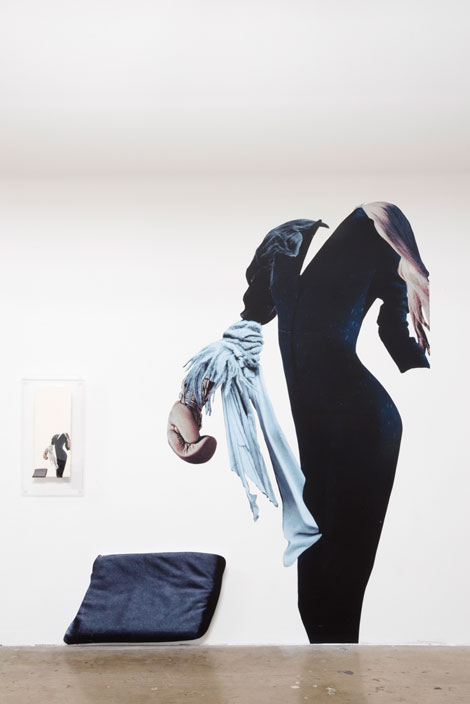Fragmented and contorted bodies in motion span the gallery as if onstage in Bettina Hubby’s exhibition “Pretty Limber.” Large-scale figures made of vinyl decals float across the space, wrapping around corners and emerging from the floor. Composited from numerous photographic sources, the entire installation feels as if one has entered a John Baldessari image. But instead of a background with the people removed, in Hubby’s work the figures are powerfully present though confined by the white walls around them, which become charged negative spaces.
Each piece is presented in two sizes; one large, shown as cutouts that project slightly from or are adhered directly to the wall, and the other in small original collages sandwiched between two pieces of plexiglas. The “who” or the “what” (including where her source materials came from) is less important than the formal relationships between the figures and the space they occupy, be it wall or paper. The large wall-mounted works overshadow the small collages, which feel like obvious referents. The collages are most successful as pages in the book Uniforms, created in conjunction with the exhibition.
Culled from myriad printed sources, Hubby combines fragments of body parts, fabric, clothing and animals to create figures whose heads, in the Dada/Surrealist tradition, are often substituted by something incongruous or missing entirely. In Load Bearing (2013) a headless male figure in a dress shirt, tie and slacks arches to the right, holding the shoes of another similarly dressed man whose body defies gravity and extends horizontally across the wall into a corner. His face is also absent, though suggested, framed by a giant woman’s red wig and a black cowboy boot. The arms of the second figure, protruding from the corner onto the next wall, meld into those of a third man who is even more drastically fragmented.
The larger-than-life size woman in She can bring home the bacon (2013) rises from the floor. Dressed in a black V-neck gown, it is unclear whether she is a superhero or a corporate executive, as her boxing glove-clad arm is relaxed rather than active. Ready at rest (2013) depicts the rear of an ambiguously gendered figure leaning forward as if part of a football huddle, hands resting on his/her buttocks. As Hubby’s montaged figures float and tumble across the wall, male and female body parts fuse to become simultaneously aggressive, standoffish and suggestive. In the back room of the gallery, she has created a boudoir and transferred her imagery onto pillows and a bedspread, emphasizing rather than masking their sexual content.
If the disembodied men and women seem complacent in, rather than critical of their situations, it speaks to the proliferation of mash-ups and remixing in contemporary culture. Hubby’s imagery appears to come from fashion magazines while her strategy takes its cues from art history. She has created an immersive installation that is captivating because of her use of the entire gallery space, yet the individual pieces (both small and large) offer little more than formal exploration of the coupling of disparate parts.



















0 Comments